
In China, when we talk about dumplings, we’re usually referring to boiled dumplings (or shui jiao, 水饺). Not potstickers, not steamed dumplings, but boiled ones. We consider it a staple, a delicious alternative to rice and noodles. You might think boiled dumplings are not as tasty as potstickers. After all, potstickers have a nicely charred surface and crispy texture and look great, right? But to us, boiled dumplings are the ultimate comfort food that we eat every week. They’re super delicious if you make them the right way.
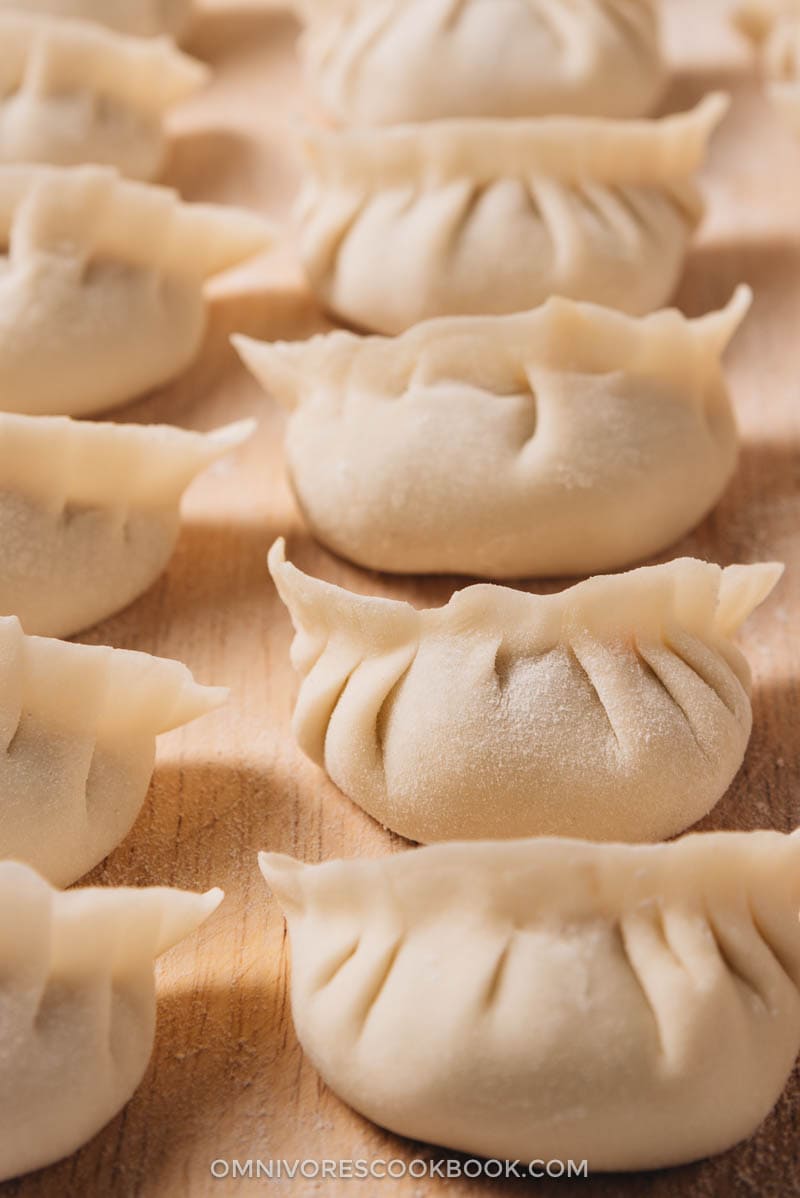
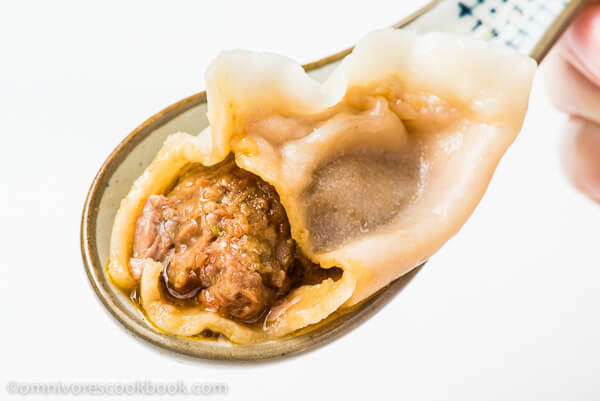
Boiled dumplings are moist and juicy. With a small bite of a dumpling, the hot and flavorful soup will drizzle from the filling. If you’ve ever tried Shanghai soup dumplings (xiao long bao, 小笼包), you know what I’m talking about. The handmade dumpling wrappers are thin, tender, and delicious. The filling is well balanced with meat and vegetable, not too greasy, nice in flavor, and comforting. Everything works perfectly together to create a fulfilling, healthy, and hearty one-dish meal.
Boiled dumplings are also the most important dish for celebrating Chinese (Lunar) New Year in northern China. My family eats them on New Year’s Eve, when all the family members are gathered at home. It is a ritual comparable to that of the roast turkey at Thanksgiving.
The pronunciation of dumpling (饺子, jiao zi) phonetically also refers to the turning point between the old year and the new year. A dumpling is shaped like an ingot (the kind used as ancient Chinese money), and this shape symbolizes wealth. Eating dumplings is a way to bring good luck, so that everything goes well in the coming new year and that family can be together.
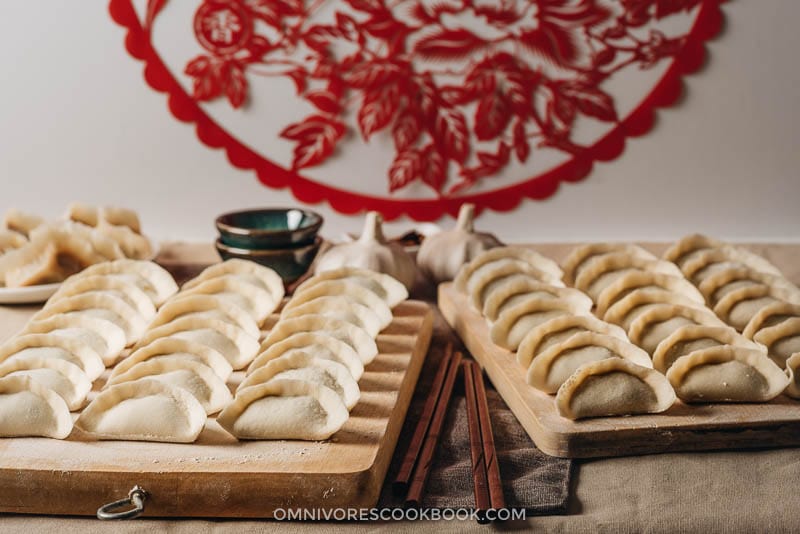
As for the fillings that can be used for boiled dumplings, the list never ends. Today I’ll give you a thorough introduction to making dumpling wrappers from scratch, wrapping dumplings, and cooking and storing them. So no matter which filling you prefer, you can always refer to this recipe to make dumplings. I will discuss dumpling fillings in another post.
Before diving into dumpling making, I need to warn you:
Why you should NOT cook boiled dumplings
- It’s not for beginners. Unlike potstickers and steamed dumplings, boiled dumplings require quite some skills to wrap so that they won’t fall apart during boiling. Unlike wontons, for which it is OK that they fall apart in the soup (because the soup is flavorful), a broken dumpling will lose almost all of its flavor. It will end up plain and tasteless.
- It requires a lot of work. To put it more precisely, it requires teamwork most of the time. One reason is that the wrappers will dry out really fast. So, unless you’re super fast, it usually requires two people for effective workflow – one person in charge of rolling the wrappers and the other person doing the wrapping.
- It’s time consuming. If you make steamed buns, you will find it only takes a few of them to make a filling meal. However, dumplings are small and super comforting, which means it’s easy for one person to finish 20 of them in no time. Thus, you will need to make a lot of dumplings.

If you haven’t closed the tab before reading this point, great! Let me explain:
Why you SHOULD cook boiled dumplings
- They are delicious and comforting. A properly made dumpling is really moist and even soupy. Compared to potstickers, their wrappers are thin and tender. The filling is very juicy and mouthwateringly good. It is the kind of comfort food that you’ll want to eat after an exhausting day at work, on a cold winter day, and when you feel under the weather.
- Teamwork is really fun and rewarding. You can get everyone in the family involved and cooking this dish together, making the cooking easier and faster. Each person will be in charge of one step of the process, and there is plenty of time for chatting and laughter throughout. Then everyone will enjoy the delicious dish that each person worked together to create. Sound good to you?
- It’s healthier and low in calories. Dumplings contain a good amount of protein, vegetables, and carbs, so they are a nutrition-balanced one-dish meal by themselves. Unlike potstickers, they don’t require any oil to grease the frying pan. So each dumpling contains fewer calories.
- It’s delicious. OK, I’ve said this once already. But it’s worth repeating!
Have I convinced you to cook some dumplings at home yet? If yes, keep reading.
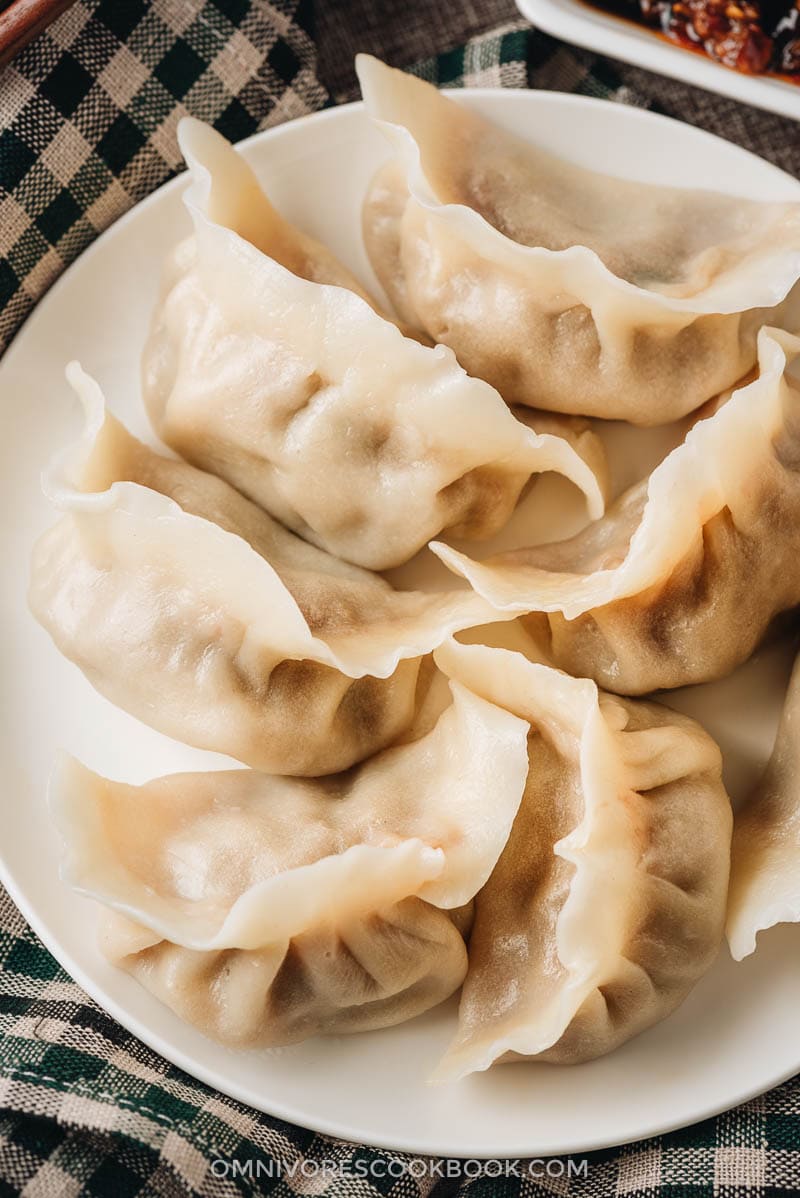
Things you should take note of
- Let the dough rest enough. If you don’t have enough time, you can use the dough after it’s rested for 1 hour, at least. But the dough will be smoother and more springy if you let it rest longer.
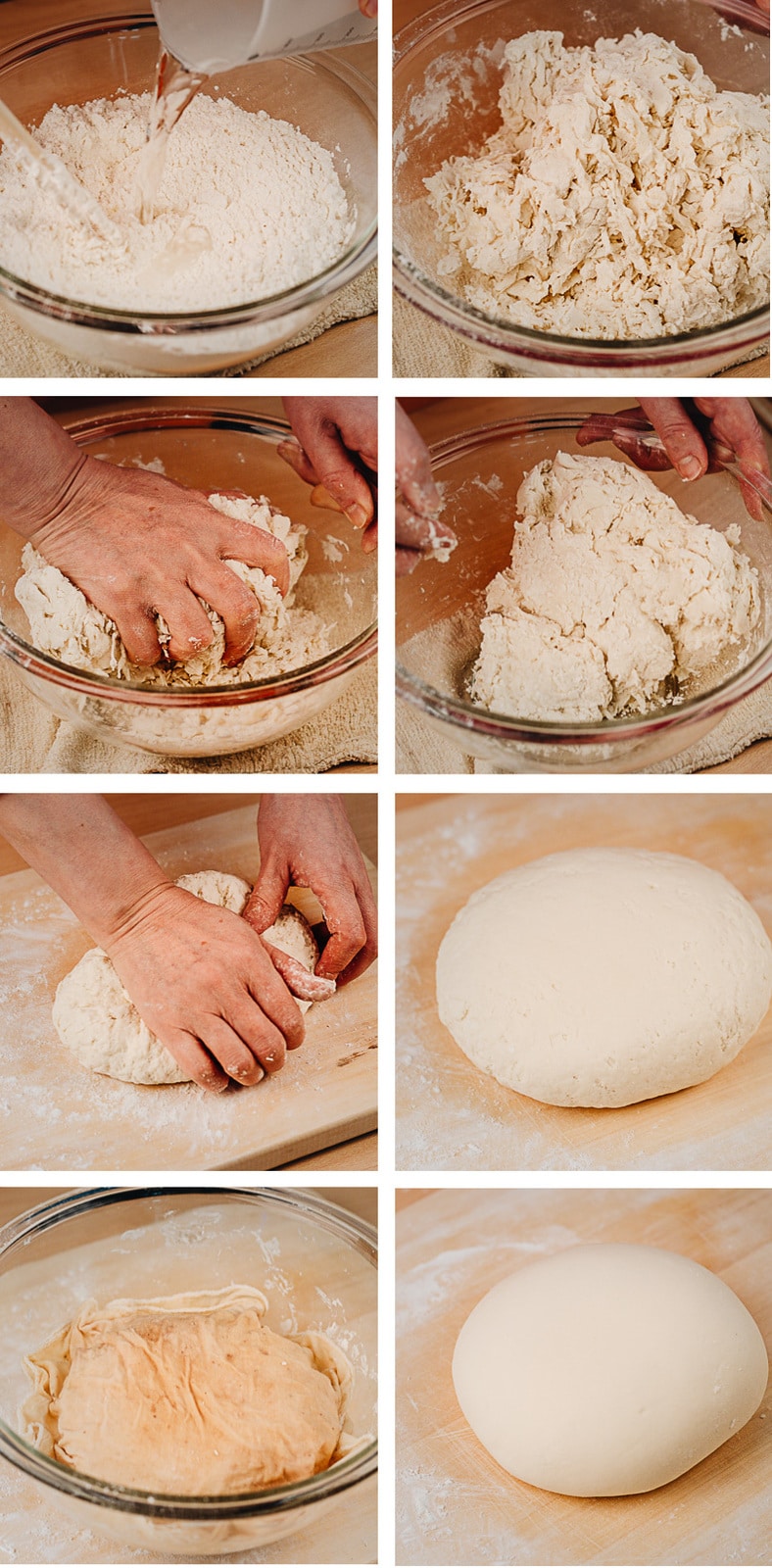
- Make tougher dough. To make the dough work, it’s better to make it a bit tougher than softer. If the dough is too tough and difficult to roll, let it rest for 3 to 4 hours; it will become soft enough to work with. But if the dough is too soft, it’ll be difficult to wrap and the dumplings won’t keep their shape.
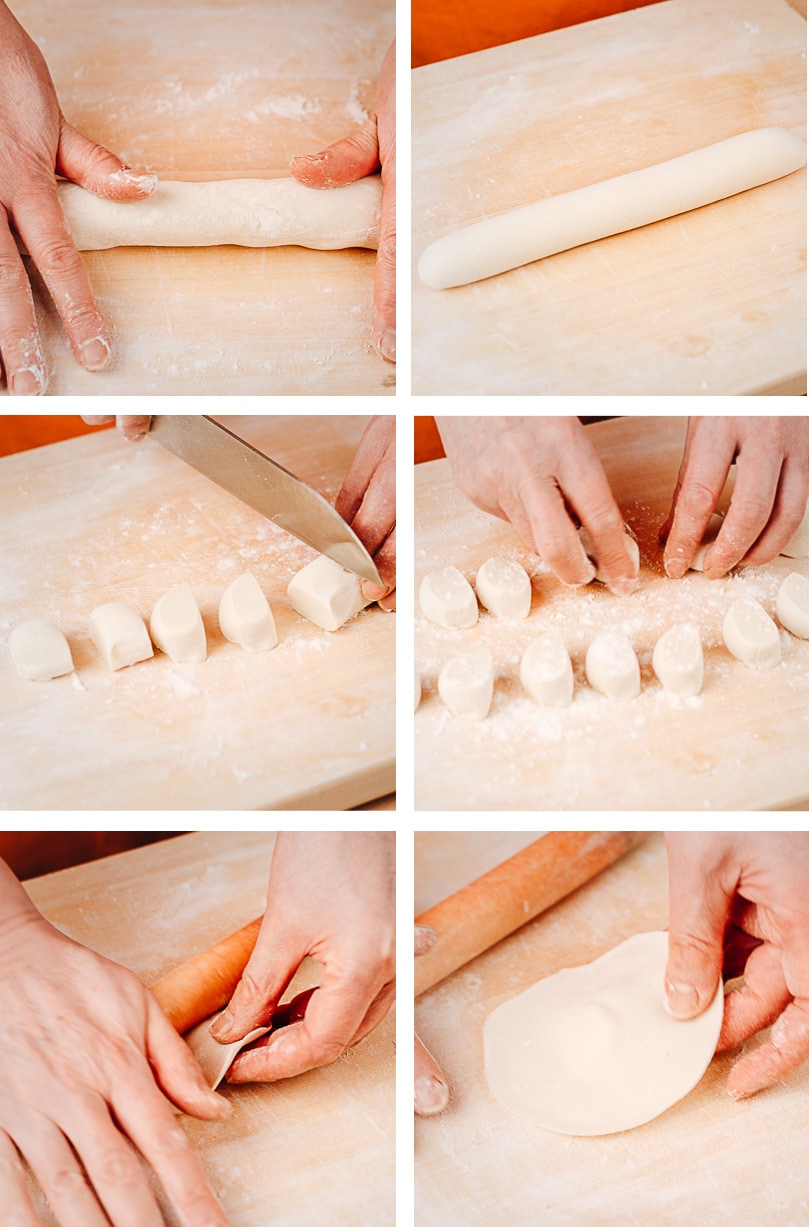
- Move fast once the wrappers are ready. Because they dry out very fast, and it will become difficult to seal the dumplings later. If you work solo, you can make small batches of wrappers (10 to 12) each time and fold the dumplings soon after. Or, you can work as a team. One person can roll the wrappers while the other person simultaneously wraps the dumplings.
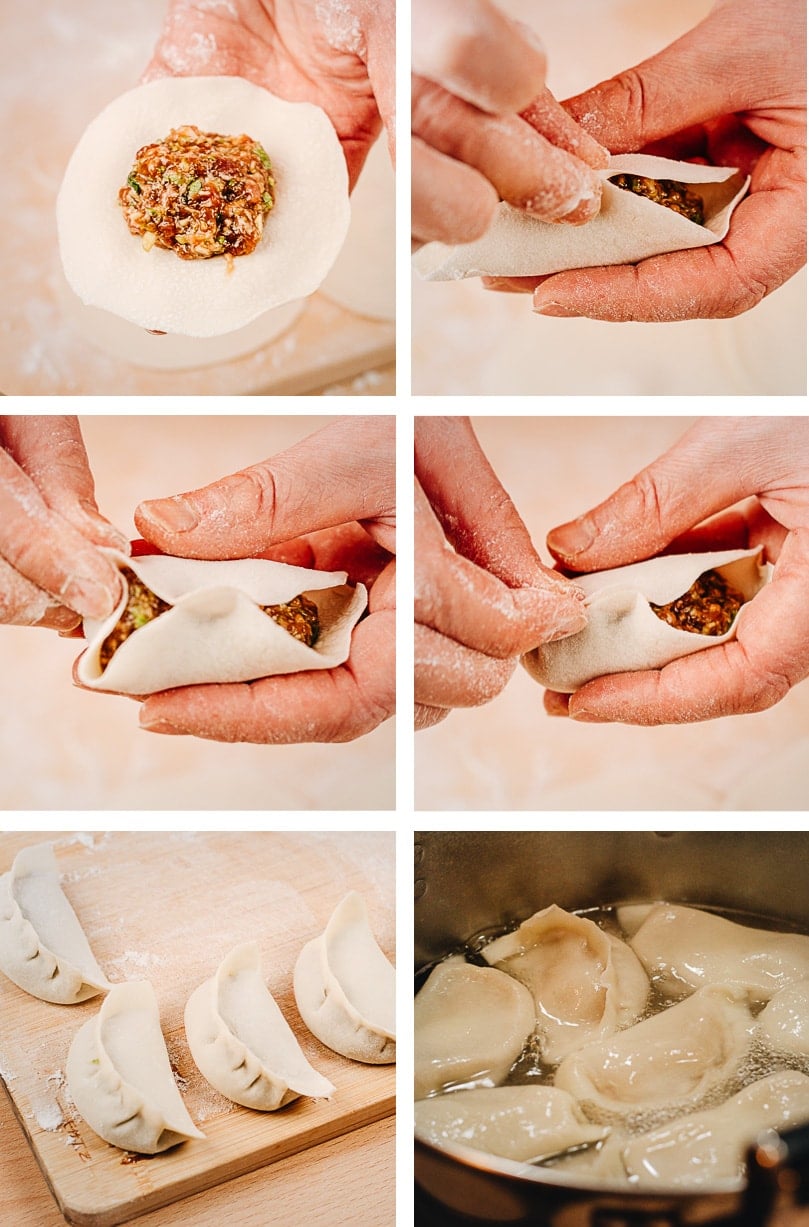
- Cook or store the dumplings soon after they’re wrapped. The dumpling filling usually contains liquid from the vegetables, and this will make the finished dumplings moist. But if you let the dumplings sit too long, the moisture will be absorbed by the dough. This will cause the dumplings to fall apart during cooking. What you can do is to freeze each small batch you just wrapped before moving onto the next batch. Cook the frozen dumplings before servings, so their texture is as good as the fresh ones.
- Cook dumplings in small batches in a large pot. Cook 20 to 25 dumplings at a time, or fewer if the dumplings are larger, so the dumplings won’t stick to the pot.
- Never take your eyes off the pot when boiling the dumplings. This is the trickiest part. The whole boiling process will be less than 5 minutes. If you leave the dumplings to cook in the water a bit longer than they need, they will start to fall apart. Check the recipe below to see how to make sure the dumplings are cooked just right.
Here is a short cooking video about how to make Chinese dumplings.
What if I still want to cook potstickers?
That is OK, because the dough can be used for both boiled dumplings and potstickers. For cooking potstickers, the process from dough-making to dumpling-wrapping is exactly the same. You can refer to the “to cook potstickers” session in the recipe next page.
When you cook potstickers, it won’t cause a big problem if the dumplings aren’t sealed well. However, I still suggest you seal them carefully. If they fall apart during cooking, the liquid will spill and evaporate, and the finished potstickers won’t be as juicy or moist.
Also take note, this dough is not for steamed dumplings. For cooking steamed dumplings, you should use hot water to make the dough, so it will be tender after steaming. See my recipe for making steamed dumplings here.
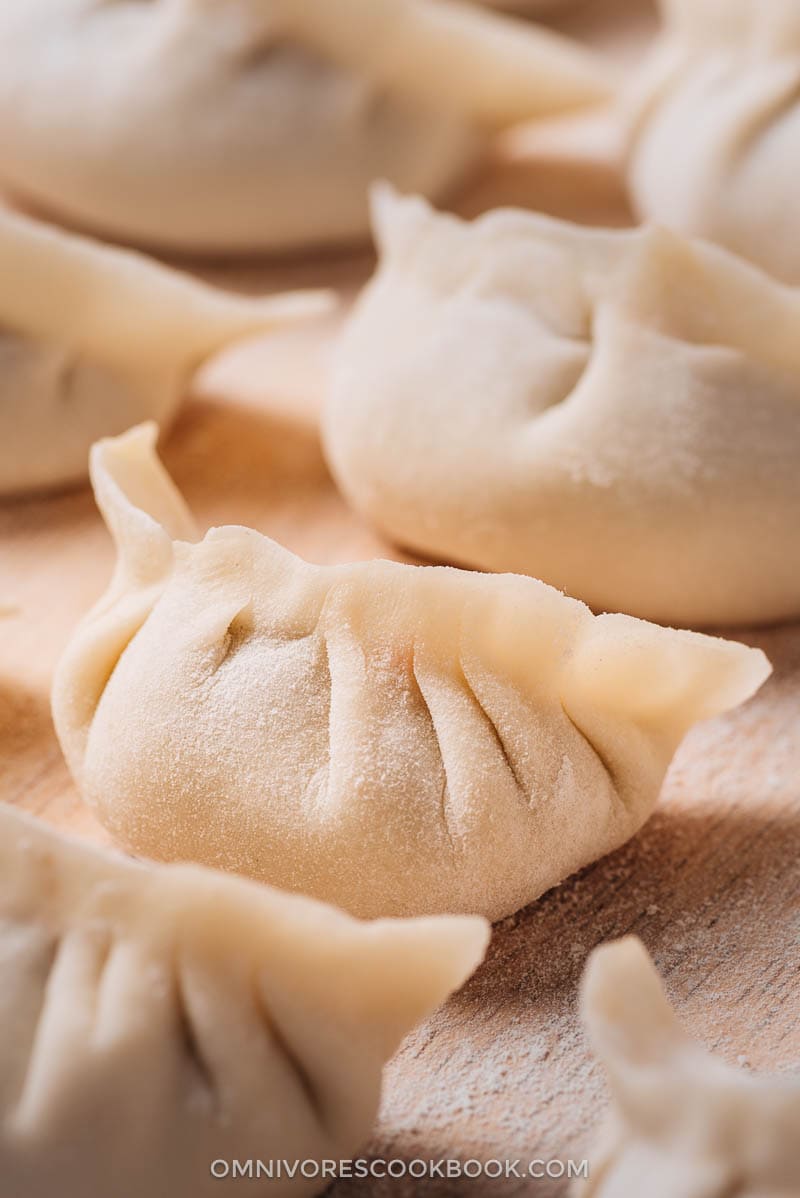
More delicious dumplings recipes
- How to Make Chinese Dumpling Sauce
- How to Make Steamed Dumplings from Scratch
- Mom’s Best Pork Dumplings with Cabbage
- Chinese Beef Dumplings
- Homemade Vegan Dumplings
- Mom’s Best Lamb Dumplings
- Carrot Dumplings
If you give this recipe a try, let us know! Leave a comment, rate it (once you’ve tried it), and take a picture and tag it #omnivorescookbook on Instagram! I’d love to see what you come up with. Cheers, friends!
Chinese Cooking Made Easy
Are you new to this website? This free email series is a great place to start. I’ll walk you through a few of my most popular recipes and show you how and why they work. You’ll quickly start to cook better Chinese food in your own kitchen.
Watch video

How to Make Chinese Dumplings from Scratch
Ingredients
Dumpling Dough
- 4 cups all-purpose flour (*see footnote 1)
- 265 ml water (room temperature) (1 cup plus 2 tablespoons)
Dumpling filling (About 4 cups preferable dumpling filling)
Dipping sauce
Instructions
To prepare the dough
- Add flour into a large bowl. Slowly pour the water into the bowl, mixing them together with a pair of chopsticks.
- When the water is mixed with the flour, dust both hands with flour and start kneading to form dough. The dough will be quite tough and should easily be able to be lifted from the bowl without sticking to the bottom.
- When dough has formed, dust the working surface with flour and dust hands again. Transfer the dough to the working surface and continue to knead it until its surface becomes smooth, about 10 minutes.
- Rinse a clean dish towel with water. Dust the bottom of a large bowl with flour and transfer the dough into it. Cover bowl with the damp dish towel and a lid (or plastic wrap). Let the dough rest for 2 hours. You can let the dough rest longer, 4 to 5 hours.
- After resting, the dough will be softened and have a smooth texture. Dust the working surface and your hands with extra flour and transfer the dough onto the surface. Knead the dough repeatedly for another 3 to 5 minutes, until the dough hardens again. Let the dough rest for about 30 minutes (or longer).
- During this time, you can prepare the dumpling filling(s).
To make dumplings
- Dust the working surface again and transfer the dough onto it. Slice 1/6 of the dough off and place the rest back to the big bowl. Cover it with the damp dish towel.
- Roll the dough into a long stick, 2.5 to 3 centimeters (1 inch) in diameter. Use a knife to cut the dough stick into about 12 small doughs, each weighing 12 to 14 grams (0.4 to 0.5 oz) (*see footnote 2).
- Slightly dust both sides of each small dough with flour. Work on them one at a time.
- Dust the working surface again. Take one dough and press it to a round disc. Roll it with a rolling pin into a round sheet (refer to the video to see how). Try to roll it so that that the edge is thinner than the center. The wrapper should be about 1 millimeter thick (i.e. almost same as the thickness of a CD), and the diameter should be about 7 centimeters. It is ok if the wrapper is not perfectly round.
- Starting here, you should work as quickly as you can, because the wrappers will dry out quickly. And if they do, you will find it very difficult to seal the dumplings later. If the wrappers dry out when you start to fold the dumplings, brush a bit of water over the edge so you can still seal the dough.
- Scoop about 1 tablespoon (or less, so you can easily fold the dumpling) of dumpling filling and place it in the center of the wrapper. Hold the dumpling with one hand and start sealing the edges with the other hand (refer to the video to see how to fold a dumpling). Be careful, when you press the edges together to seal the dumpling, do not let filling touch the sealing area (the dumpling will fall apart if you do). After folding, press edge again to seal well. You don’t need to fold beautiful dumplings here; our goal is to make the dumplings hold their shape during boiling.
- Place the dumplings on the working surface and work on the rest of the doughs in the same manner.
- Try to wrap and cook dumplings in small batches (20 to 25 dumplings at a time). If you won’t cook dumplings soon after wrapping (within 30 minutes), freeze them first (refer to the session “to store dumpling” below). If you want to know the reason, read the session of “Things you should take note of” above.
To cook boiled dumplings
- Bring a large pot of water to a boil.
- Carefully add dumplings one at a time into the water. Use a big ladle to stir the water gently and continuously, until the water starts to boil again, so the dumplings won’t stick to the bottom, for about 1 minute. Adjust the heat so the water is at boiling point, but isn’t bubbling too fiercely.
- When the dumplings float to the surface, continue boiling until the dumplings are filled with air and swollen, and the dough starts to become transparent, about 1 minute (*see footnote 3). Immediately transfer all the dumplings to a plate.
- (*) Be careful, the dumplings cook quickly and you should always stand beside the pot throughout the boiling process. When the dumplings are cooked, they will start to fall apart within seconds, so transfer them as soon as possible.
To cook potstickers
- Heat a tablespoon of oil in a nonstick skillet over medium high heat. When oil is hot, place potstickers in the skillet, pleat side up.
- Swirl 2 tablespoons water in the skillet, cover immediately, and turn the heat to medium. Cook covered until the water is evaporated and potstickers are cooked through, 3 to 4 minutes.
- Remove the cover and flip one potsticker to see whether the bottom side is charred. If not, turn to medium high heat and cook until the bottom side turns golden brown.
- Transfer the potstickers to a plate.
To serve dumplings
- Option 1: Serve with Chinese black vinegar and a few ginger slices.
- Option 2: Serve with 1 tablespoon Chinese black vinegar + 1 teaspoon light soy sauce + 1/2 teaspoon sesame oil.
- Option 3: Serve with Chinese black vinegar and a few drops fresh Chili oil.
To freeze raw dumplings
- If you plan to store dumplings or won’t serve them immediately, always freeze them uncooked. It won’t affect the texture or flavor of the dumplings.
- Dust the bottom of a big airtight box with a thin layer of flour. Place the dumplings, one finger’s width apart. Store in the freezer for up to 2 months.
To cook frozen dumplings
- Bring a large pot of water to a boil. Add dumplings into the water. Use a big ladle to stir a few times. Cover and cook until the water starts to boil again. Adjust the heat so the water will keep boiling without spilling. Cover and cook for 3 minutes (up to 5 minutes for bigger dumplings). Uncover pot. Continue to cook for about 1 minute (up to 2 minutes for bigger dumplings), until cooked through. Transfer to a plate immediately.
To store and reheat cooked dumplings
- Store leftover boiled dumplings in airtight container in the fridge and consume as soon as possible, within 1 to 2 days.
- To reheat in microwave – Add dumplings into a bowl and sprinkle with a few drops of water. Cover and heat until warm.
- To reheat by steaming – Place dumplings in a bowl. Place a tall-rimmed plate upside down in a pot and add water to cover. Place the bowl of dumplings on top. Heat over high heat until water is boiling. Continue cooking for 5 minutes.
- To pan fry – Grease a nonstick skillet with a thin layer of oil and heat over medium heat. When skillet is hot, add dumplings. Swirl in a tablespoon of water, cover immediately, and cook for 2 to 3 minutes.
Notes
- Make sure you sift the flour into the cup and level it with a chopstick. If you scoop the flour with the cup directly, you will end up with 1/3 too much flour.
- This recipe makes relatively small dumplings. They are easier to wrap and work better for fillings that contain more moisture. Depend on the filling you use, you can also make slightly bigger dumplings.
- The cooking time here is just for reference. Actual cooking time will depend on the heat, the type of stove you use, the size of the dumplings, and the type of filling.
Nutrition

Did you make this recipe?
I’d love to hear how it turned out for you! Please take a moment to leave a 5-star rating ⭐️ and share your thoughts in the comments further down the page. It really helps others discover the recipe too.

Amen
This was for a project and I Saw your video and I made it I got it A for my grade
thanks
amen
I is so good I love bro the best good food everrrrr
Katarina
I love it, thank you
Pernilla
Hi! I’m wondering what cups you use in this recipe, metric (250 ml) or American (236 ml)? Since you used ml for the water I’m inclined to think it’s metric cups, but I also saw that you are based in the USA, so maybe not. Since it seems important that the measurements are exact, the difference would seem to matter. Thank you!
Maggie Zhu
I used American measured (240 ml). That being said, it’s important to observe the dough and adjust the water flour ratio during the kneading.
I actually developed this recipe when I was still living in China. After moving to the US, a lot of my dough measurements changed because the flour is very different from China (slightly higher gluten, water absorption rate is different). Also, when you’re measuring flour by cups, the weight changes a lot depending on how you pack the flour.
When you stir the water and flour together, it forms dough flakes at the beginning. There will be some dry flour once the water is fully mixed in, but you might need to add more water if there’s too much dried water left on the bowl. After start kneading the dough, it’s easier to add more flour if the dough turned out too wet (if it sticks to the bowl or your working surface a lot). Eventually it forms a dough that is not wet but also not too stiff (otherwise it’s hard to roll). The resting allows the gluten to relax, so you can roll it out later.
Pernilla
Thank you for the reply! I’m in Sweden so I guess I’ll have to experiment and adjust it for the plain flour we have here. So I’ll use a metric cup but will add the flour little by little so I can stop when I think it’s good!
Kate
Hi Maggie. Are the dumpling wrappers only dusted with plain flour, not corn starch? I work so slow and when I get to add the filling, the wrappers have stuck together, even though I had made sure to dust them generously.
Maggie Zhu
When we make wrappers at home, we do use plain flour instead of cornstarch. But if you buy commercial wrappers, they do use cornstarch. Next time you can try with cornstarch and I think it might work slightly better.
The wrappers tend to stick together regardless if leave them stacked together for a long time. The best solution is to make a dozen of wrappers at a time, then wrap them up. And make more wrappers.
Reni
It was my third time making dumplings today (that is if you only count this kind > 🥟). I used the filling from the sauerkraut & pork dumpling recipe + this dough! They turned out wonderful and soupy. I have freezed a ton of them for later, and even had leftover filling that I mixed with panko, an egg, veggies & some more flavouring to make “meatballs” (more vegetable than meat, really.) Delicious and useful, thank you!
MaryAnne Lee
Thanks for the video, I usually buy the ready make. This Recipe I will keep and can made dumplings any time.
Sheida
I just finished making these; it was easy and simple to follow. I did both the boil and potsticker with same dough. They were delicious so much that I didn’t even get to take pics my family ate them literally out of the pot. I have dietary restrictions and digestion issues so I can’t eat alot of food; I have been told to just go vegan but hard with kids (13 & 4 yrs) so I used cabbage, carrot, egg and pokchoy mix with almond butter for the oil and the filling was just right too. Thank you, I have one more food in my corner now. 🙂
Maggie Zhu
I’m glad to hear you liked the recipe, and thanks for leaving a positive review! For dumplings made from scratch, you should be eating them out of the pot when they are the most fresh 🙂 My family back in China always eat it like that.
For veggie heavy dumpling fillings, I think these recipes are fun:
Vegan dumplings: https://omnivorescookbook.com/vegan-dumplings/
Carrot and egg filling: https://omnivorescookbook.com/carrot-dumplings
Magalie
Good Evening Maggie, please the plant base cookbook is the only cookbook you have. I am looking for a cookbook with meat of all the beautiful recipe you have. Thank you
Helen
I’m desperate to try making and eating these delicious looking dumplings, however I have a gluten intolerance, do you know if it’s possible to make them with gluten free flour and if so which one would you recommend please?
Maggie Zhu
I’m afraid I don’t have much experience with gluten free flour. I think you might find more information on other gluten-free website.
I also think if you’re using a gluten free flour, the dumplings should be steamed or pan fried instead of boiled, so they won’t fall apart during cooking.
Josephine.Mutabuza
I loved this recipe, it was very practical and easy to follow.
Adrienne
Because of the pandemic, my brother’s partner hasn’t been able to see her family in central China for the past two years. She was missing the tradition of making dumplings with her family, so I followed your recipe to make it happen at ours! The dough turned out great and though the dumplings were not quite Instagram-worthy, they held together thanks to these thorough instructions and were tons of fun to make, involving my husband, brother and his partner, my mom, and my grandma. It was so much fun that I think we’ll make it a tradition in our (southern Chinese) family too. So gratifying to be able to learn something new and to make memories while doing it. Thanks so much Maggie!
Fatima
Hi Maggie! Thanks for explaining so well. When I make dumplings, I always add an egg cause I’m scared the flour and water ones will fall apart when dipped in for boiling. I’m pakistani and my family loves dumplings, will try this recipe, for sure an diet you know. Happy New year :)!!!!
Maggie Zhu
The key is to make the dough fresh and pliable enough so the sealing stick together. You definitely need to cover the dough and dumplings all the time to prevent the dough from drying out, which also affect the cooking. As long as the dough is made fresh (and not the dumpling wrappers you purchase), it should hold up in the water.
Happy Lunar New Year!
Kim
Hey. Thank you for detailed and helpful instruction with wonderful recipes.
Emily
Today is the fourth time we have made dumplings using your recipes. They are great!
We have some left over wrapper dough. Can we freeze it?
Maggie Zhu
Hi Emily, you can freeze the dough. Glad to hear you like the recipe 🙂